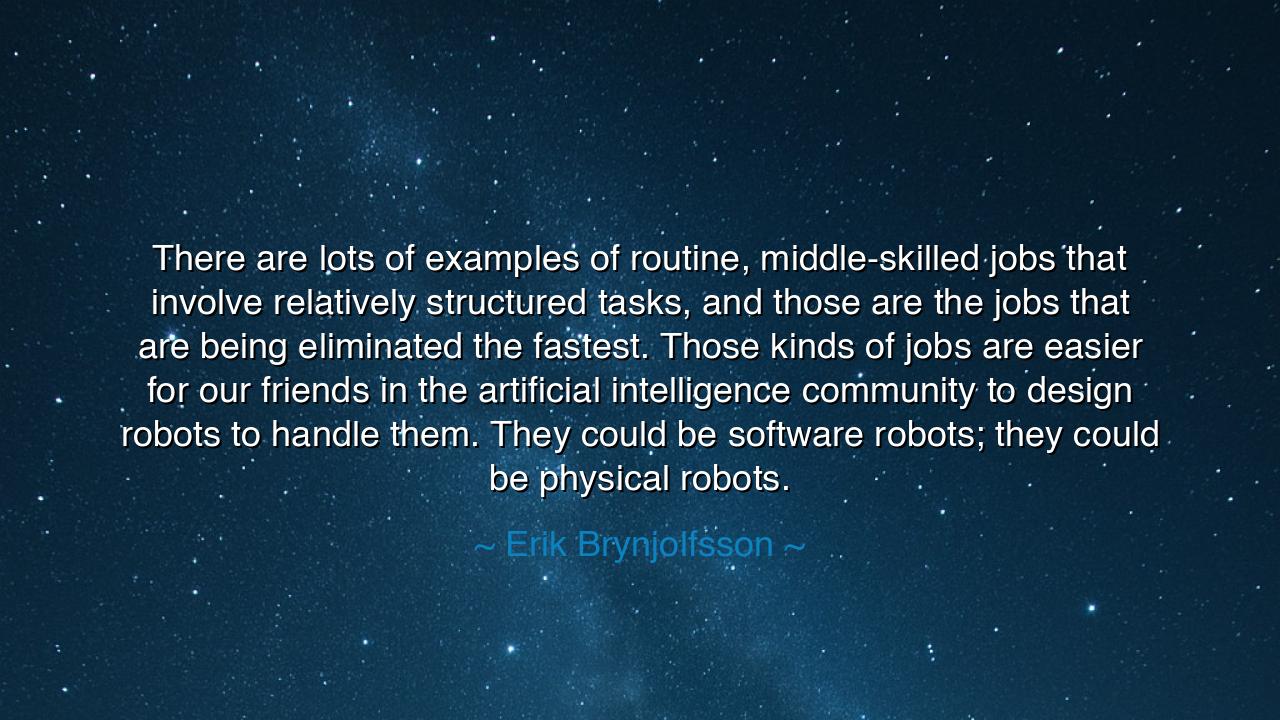
There are lots of examples of routine, middle-skilled jobs that
There are lots of examples of routine, middle-skilled jobs that involve relatively structured tasks, and those are the jobs that are being eliminated the fastest. Those kinds of jobs are easier for our friends in the artificial intelligence community to design robots to handle them. They could be software robots; they could be physical robots.






In the words of Erik Brynjolfsson, scholar of the digital age and chronicler of the new machine world, there echoes both warning and wonder: “There are lots of examples of routine, middle-skilled jobs that involve relatively structured tasks, and those are the jobs that are being eliminated the fastest. Those kinds of jobs are easier for our friends in the artificial intelligence community to design robots to handle them. They could be software robots; they could be physical robots.” Behind these calm, analytical words lies a message of transformation as profound as any in human history. For he speaks of a new dawn — the age of automation, when the creations of human ingenuity begin to mirror, and even surpass, their creators.
The origin of Brynjolfsson’s insight lies in his study of the digital revolution, that vast and silent tide reshaping the world. He stands among those who, like the prophets of old, read the signs in the sky — except that these constellations are made not of stars, but of circuits and algorithms. Where once the hammer, the loom, and the plow transformed the earth, now the robot and the software reshape the fabric of society itself. The scholar warns that this change does not strike equally. It begins by sweeping away the routine tasks, the repetitive and predictable labors that once formed the backbone of the middle class. For such tasks — measured, structured, and rule-bound — are the easiest for artificial intelligence to imitate.
Think of the weavers of Nottingham in the early 19th century, whose skill was displaced by the mechanical loom. They, too, lived at the edge of transformation. Their craft, once proud and secure, was unmade by the precision of gears and the relentless rhythm of machines. Many rose in rebellion — the Luddites, who smashed the looms not from ignorance, but from grief. Yet their destruction could not halt the advance of progress. So too now, in our age, as the looms of thought — the algorithms and software robots — begin to weave the patterns once made by human minds. The factory has moved into the cloud; the worker, into uncertainty.
Brynjolfsson’s words are not merely technical; they are moral. He reminds us that every age of invention carries both creation and displacement. When robots take over the routine, humanity must not despair, but must ascend — must seek the higher ground of creativity, empathy, and vision. For the machine can repeat, but it cannot dream; it can calculate, but it cannot care. Those who cling to the security of repetition will find themselves overtaken, but those who embrace learning, imagination, and flexibility will rise anew. The future, then, belongs not to the efficient, but to the inspired.
There is wisdom in this, for it speaks to the eternal law of change: that which does not evolve is swept aside. The farmer who feared the tractor, the scribe who feared the printing press, the mapmaker who feared the satellite — all stood where we stand now. The robots, whether of steel or code, are not our enemies; they are our mirrors, reflecting what we once were, and challenging us to become something greater. The tragedy is not that machines are learning to work, but that too many humans have forgotten how to create.
Consider the story of Kodak, the mighty empire of film, undone not by rivals, but by its own blindness to change. Its engineers invented the digital camera — yet the company hid it away, fearing it would cannibalize their profits. While they protected the familiar, the world moved on. In this, we see the fate of all who resist transformation. Routine, however profitable, is a fragile fortress. Innovation is the only enduring security.
Therefore, O reader of the future, take heed of Brynjolfsson’s warning. Do not fear the robots; fear stagnation. Do not cling to the comfort of the routine; seek instead the mastery of the creative. The age of automation is not the end of human worth — it is the test of it. Learn, adapt, imagine — these are the shields against obsolescence. The machine may replace the worker, but it can never replace the thinker, the dreamer, the builder of meaning.
So remember this: in every age when the tools of men outgrow their makers, those who survive are not those who resist the new, but those who redefine what it means to be human. Let your labor rise beyond the mechanical; let your spirit shape the future as your ancestors once shaped fire and stone. For the world belongs not to those who repeat, but to those who renew.






AAdministratorAdministrator
Welcome, honored guests. Please leave a comment, we will respond soon